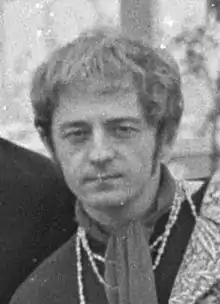Mike Hugg | |
|---|---|
 | |
| Background information | |
| Birth name | Michael John Hugg |
| Born | 11 August 1940 Gosport, Hampshire, England |
| Genres | |
| Occupation(s) |
|
| Instrument(s) |
|
| Years active | 1962–present |
| Website | www |
Michael John Hugg (born 11 August 1940) is a British musician who was a founding member of the 1960s group Manfred Mann.[1]
Career
Manfred Mann
Hugg first thought about wanting a career in music when he was sixteen years old.[2] Pursuing a career in jazz, he met the pianist Manfred Mann while working as a musician at Butlin's Clacton, and they formed a seven-piece group. The Mann–Hugg Blues Brothers recruited Paul Jones and later Tom McGuinness.[3] Upon their signing with HMV Records, their producer, John Burgess, changed their name to Manfred Mann.
Hugg is a competent pianist and an able vibraphone player, but his main role in Manfred Mann was as drummer. However, he recorded several vibraphone solos with the band (e.g. "I'm your Kingpin") and used the instrument to augment hits such as "Oh No Not My Baby". He was credited as co-writer of the group's early hits and contributed solo compositions throughout its life, including jazzy instrumentals ("Bare Hugg") and wistful acid-pop ("Funniest Gig", "Harry the One Man Band"). His abilities as a songwriter grew throughout the group's career.[4]
Solo career
He and his brother composed "Mister, You're a Better Man Than I" which was recorded by the Yardbirds in 1965. Hugg also composed the majority of the songs for the 1968 Paramount film Up the Junction,[5] as well as co-writing the theme from the BBC sitcom Whatever Happened to the Likely Lads with La Frenais, and was recorded by Hugg's session featuring Tony Rivers on lead vocals.
In 1972, he released his debut solo album, "Somewhere". The next year, "Stress & Strain" was made. In 1975, Hugg was a member of the group "Hug" who released one studio album titled "Neon Dreams".[6] By the early 1980s, he was working with a Fairlight, one of the first computer musical instruments.[2] In 2015, he released a solo album with help from Simon Currie (who is currently in the Manfreds).[2] Hugg formed the acoustic jazz trio PBD.
The Manfreds
In 1991, Hugg formed The Manfreds with some of the original members of Manfred Mann, without Manfred Mann himself (which was why they were "The Manfreds" instead of being a reformed Manfred Mann). Hugg retired from touring in 2022, but is still turning up with them for private bookings and small gigs. According to Paul Jones, Hugg was the oldest member of Manfred Mann in the Manfreds, and that his decision to retire from touring was because he had been off from many concerts with "ear problems".[7]
Discography
- Solo
- 1972 Somewhere
- 1973 Stress & Strain
- Manfred Mann Chapter Three
- 1969 Manfred Mann Chapter Three
- 1970 Manfred Mann Chapter Three Volume Two
- 1971 Manfred Mann Chapter Three Volume Three (unreleased)
- Hug
- 1975 Neon Dream
See also
References
- ↑ Rawlings, Terry (2002). Then, Now and Rare: British Beat 1960–1969. Omnibus Press. p. 122. ISBN 978-0-7119-9094-4.
- 1 2 3 "THE OFFICIAL MANFREDS WEBSITE - Mike Hugg". www.themanfreds.com. Retrieved 8 January 2024.
- ↑ Interview Archived 27 September 2011 at the Wayback Machine. Retrosellers.com. Retrieved 27 August 2011.
- ↑ Manfred Mann. Starling.rinet.ru. Retrieved 27 August 2011.
- ↑ Eder, Bruce. (11 August 1942) Mike Hugg. AllMusic. Retrieved 27 August 2011.
- ↑ Hug - Neon Dream Album Reviews, Songs & More | AllMusic, retrieved 8 January 2024
- ↑ "60s icons The Manfreds back with celebratory tour". Cambridge Independent. 27 October 2023. Retrieved 8 January 2024.
External links
- Mike Hugg on the Manfreds' official website
- Mike Hugg discography at Discogs
- Mike Hugg at IMDb
- cigar advert on YouTube